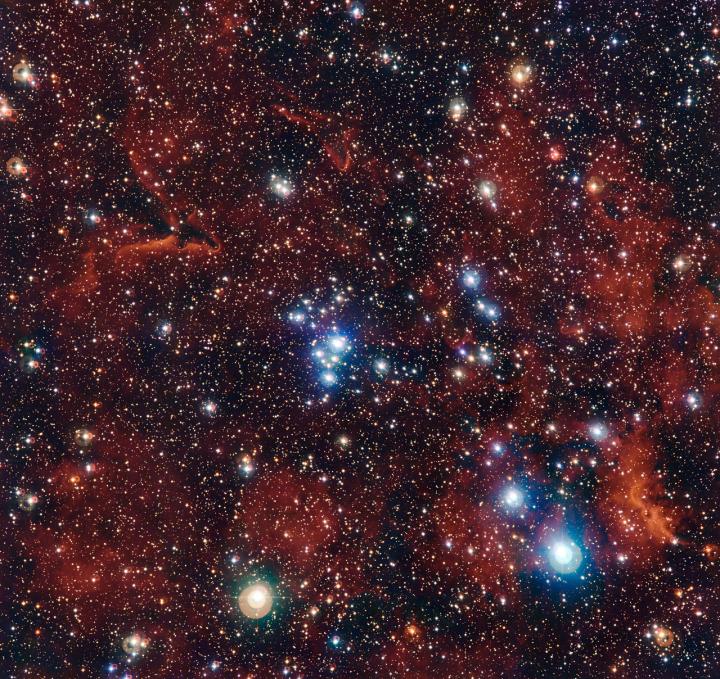Buried in the heart of a giant

This rich view of an array of colorful stars and gas was captured by the Wide Field Imager (WFI) camera, on the MPG/ESO 2.2-meter telescope at ESO's La Silla Observatory in Chile. It shows a young open cluster of stars known as NGC 2367, an infant stellar grouping that lies at the center of an immense and ancient structure on the margins of the Milky Way. Credit: ESO/G. Beccari
Open clusters like NGC 2367 are a common sight in spiral galaxies like the Milky Way, and tend to form in their host's outer regions. On their travels about the galactic centre, they are affected by the gravity of other clusters, as well as by large clouds of gas that they pass close to.
Because open clusters are only loosely bound by gravity to begin with, and because they constantly lose mass as some of their gas is pushed away by the radiation of the young hot stars, these disturbances occur often enough to cause the stars to wander off from their siblings, just as the Sun is believed to have done many years ago. An open cluster is generally expected to survive for a few hundred million years before it is completely dispersed.
In the meantime, clusters serve as excellent case studies for stellar evolution. All the constituent stars are born at roughly the same time from the same cloud of material, meaning they can be compared alongside one another with greater ease, allowing their ages to be readily determined and their evolution mapped.
Like many open clusters, NGC 2367 is embedded within an emission nebula), from which its stars were born. The remains show up as wisps and clouds of hydrogen gas, ionised by the ultraviolet radiation being emitted by the hottest stars. What is more unusual is that, as you begin to pan out from the cluster and its nebula, a far more expansive structure is revealed: NGC 2367 and the nebula containing it are thought to be the nucleus of a larger nebula, known as Brand 16, which in turn is only a small part of a huge supershell, known as GS234-02.
The GS234-02 supershell lies towards the outskirts of our galaxy, the Milky Way. It is a vast structure, spanning hundreds of light-years. It began its life when a group of particularly massive stars, producing strong stellar winds, created individual expanding bubbles of hot gas.
These neighbouring bubbles eventually merged to form a superbubble, and the short life spans of the stars at its heart meant that they exploded as supernovae at similar times, expanding the superbubble even further, to the point that it merged with other superbubbles, which is when the supershell was formed. The resulting formation ranks as one of the largest possible structures within a galaxy.
This concentrically expanding system, as ancient as it is enormous, provides a wonderful example of the intricate, interrelated structures that are sculpted in galaxies by the lives and deaths of stars.
###
More information
ESO is the foremost intergovernmental astronomy organisation in Europe and the world's most productive ground-based astronomical observatory by far. It is supported by 16 countries: Austria, Belgium, Brazil, the Czech Republic, Denmark, France, Finland, Germany, Italy, the Netherlands, Poland, Portugal, Spain, Sweden, Switzerland and the United Kingdom, along with the host state of Chile. ESO carries out an ambitious programme focused on the design, construction and operation of powerful ground-based observing facilities enabling astronomers to make important scientific discoveries. ESO also plays a leading role in promoting and organising cooperation in astronomical research. ESO operates three unique world-class observing sites in Chile: La Silla, Paranal and Chajnantor. At Paranal, ESO operates the Very Large Telescope, the world's most advanced visible-light astronomical observatory and two survey telescopes. VISTA works in the infrared and is the world's largest survey telescope and the VLT Survey Telescope is the largest telescope designed to exclusively survey the skies in visible light. ESO is a major partner in ALMA, the largest astronomical project in existence. And on Cerro Armazones, close to Paranal, ESO is building the 39-metre European Extremely Large Telescope, the E-ELT, which will become “the world's biggest eye on the sky”.
Links
Photos of the MPG/ESO 2.2-metre telescope – http://www.
Contacts
Richard Hook
ESO Public Information Officer
Garching bei München, Germany
Tel: +49 89 3200 6655
Cell: +49 151 1537 3591
Email: rhook@eso.org
Media Contact
All latest news from the category: Physics and Astronomy
This area deals with the fundamental laws and building blocks of nature and how they interact, the properties and the behavior of matter, and research into space and time and their structures.
innovations-report provides in-depth reports and articles on subjects such as astrophysics, laser technologies, nuclear, quantum, particle and solid-state physics, nanotechnologies, planetary research and findings (Mars, Venus) and developments related to the Hubble Telescope.
Newest articles

Silicon Carbide Innovation Alliance to drive industrial-scale semiconductor work
Known for its ability to withstand extreme environments and high voltages, silicon carbide (SiC) is a semiconducting material made up of silicon and carbon atoms arranged into crystals that is…

New SPECT/CT technique shows impressive biomarker identification
…offers increased access for prostate cancer patients. A novel SPECT/CT acquisition method can accurately detect radiopharmaceutical biodistribution in a convenient manner for prostate cancer patients, opening the door for more…

How 3D printers can give robots a soft touch
Soft skin coverings and touch sensors have emerged as a promising feature for robots that are both safer and more intuitive for human interaction, but they are expensive and difficult…





















